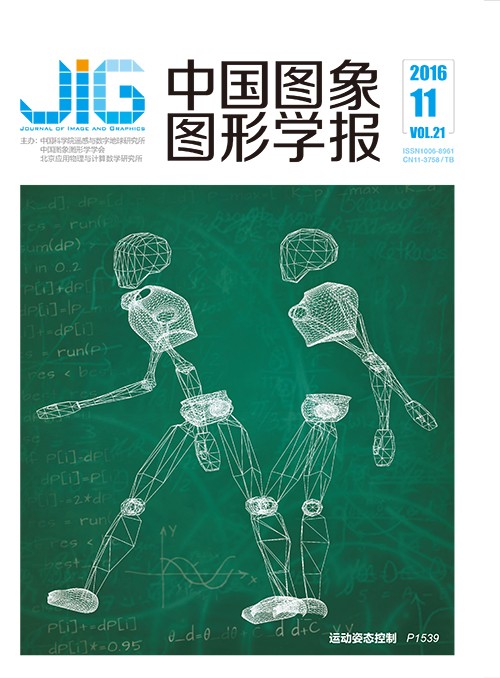
图像边缘轮廓自适应阈值的角点检测算法
摘 要
目的 基于边缘轮廓的角点检测算法的检测性能虽然相对比较稳定,但是它对边缘轮廓的局部变化敏感,并且只是给予一个经验门限去提取角点,为此提出一种对局部变化和噪声稳健的基于图像边缘轮廓自适应阈值的角点检测算法。方法 该算法利用各向异性高斯方向导数滤波器对不同边缘和角点模型进行表征,提取表征边缘和角点的灰度及几何变化的不变属性,并通过正则化计算得到区别边缘和角点的自适应阈值。该算法首先利用Canny边缘检测器检测输入图像的边缘映射并从边缘映射中提取出边缘轮廓;然后利用各向异性高斯方向导数滤波器对所提取出的边缘曲线进行滤波平滑,计算出每一像素点的响应并与自适应阈值作比较,把响应大于阈值的点作为候选角点;最后,对候选角点进行非极大值抑制得到最终角点集。结果 提出的算法分别与Harris算法,He & Yung算法,以及ANDDs算法在仿射变换和高斯噪声的实验环境下进行比较,其性能指标为平均重复率与定位误差;并且对每个角点检测算法在无噪声和有噪声的情况下进行了角点匹配比较。4种算法的两个指标的平均排名为Harris 3.375,He &Yung 2.625,ANDDs 2.625,本文算法 1.375。本文算法在仿射变换以及高斯噪声的情况下有着良好的平均重复率和定位误差,优于其他3种算法。匹配实验中的错误点以及丢失点也少于其他3种算法。结论 图像的特征检测在计算机视觉领域是一个重要的课题,在许多视觉系统中,检测特征往往作为复杂计算的第1步。因此,这一步的可靠性会极大地影响着视觉系统整体的结果。而角点作为图像的重要特征,对其研究具有重大意义。本文算法不同于传统的基于边缘的角点检测器仅利用边缘轮廓的信息,还利用到图像边缘像素的灰度信息。而且,本文算法还采用一个自适应全局阈值,避免了角点的误判。正则化的灰度变化有效减少了噪声或者光照对检测性能的影响。通过角点匹配实验、仿射变换实验以及高斯噪声实验,可以看出,本文的角点检测器拥有良好的检测性能,并且对噪声具有稳健性。
关键词
Novel contour-based corner detection with adaptive threshold
Zhao Yali, Zhang Weichuan, Li Yunhong(College of Electronics and Information, Xi'an Polytechnic University, Xi'an 710048, China) Abstract
Objective Corner detection is a major research area in computer vision. Many algorithms of corner detection have been proposed in recent years. The existing methods can be divided into intensity-, contour-, and template-based approaches. The detection performance of contour-based corner detection is relatively stable, but this approach is sensitive to local variation and noise on the curve. Many contour-based image corner detectors provide only an empirical threshold to extract the corner. Thus, this paper proposes a novel contour-based corner detection with adaptive threshold, and this algorithm has a robust performance in local variation and noise on the curve. Method The proposed method is based on anisotropic Gaussian directional derivative (ANDD) representations, and searches the invariant property of geometry and gray level in edges and corners. The adaptive threshold of the difference between the edge and corner points is obtained by the regularization calculation. This corner detection finds the edge map using the Canny edge detector and extracts edges from the edge map first. The ANDD filter is then used to filter the extracted edge curves, and the response of each pixel is calculated and compared with the adaptive threshold value. Then, the point value that is higher than the threshold value is chosen as the candidate corner. Finally, the non-maximum suppression is applied to the candidate corner set and the final corners are obtained. Result The proposed detector is compared with three different detectors under affine transforms and Gaussian noise degradation. The evaluation criteria of performance are average repeatability and localization error. In simulation experiments, the average rankings of four algorithms are as follows: Harris (3.375), He and Yung (2.625), ANDDs (2.625), and the proposed method (1.375). The corner matching performance of the corner detection algorithms are compared under the noise-free and noisy environments. Experimental results show that the proposed method attains excellent performance on average repeatability and localization error under affine transforms and Gaussian noise degradation. The number of false and missed corners is less than that of the three other corner detectors in matching experiments. Conclusion The proposed corner detection is a contour-based method with an adaptive threshold. Similar to most contour-based algorithms, the proposed method detects the edge map of input image using the edge detector first and then extracts the edges from the edge map. However, the proposed algorithm is different from the traditional contour-based corner detection using only the edge information. The proposed algorithm also utilizes intensity variations of pixels on edges. Furthermore, the new method uses a global adaptive threshold to avoid erroneous judgment of corners. The sum of normalized intensity variations effectively reduces the influence of noise or illumination on detection performance. As obtained from experiments of corner matching, affine transforms, and Gaussian noise degradation, the proposed method shows excellent performance in terms of detection accuracy, average repeatability, localization error, and noise robustness.
Keywords
|



 中国图象图形学报 │ 京ICP备05080539号-4 │ 本系统由
中国图象图形学报 │ 京ICP备05080539号-4 │ 本系统由